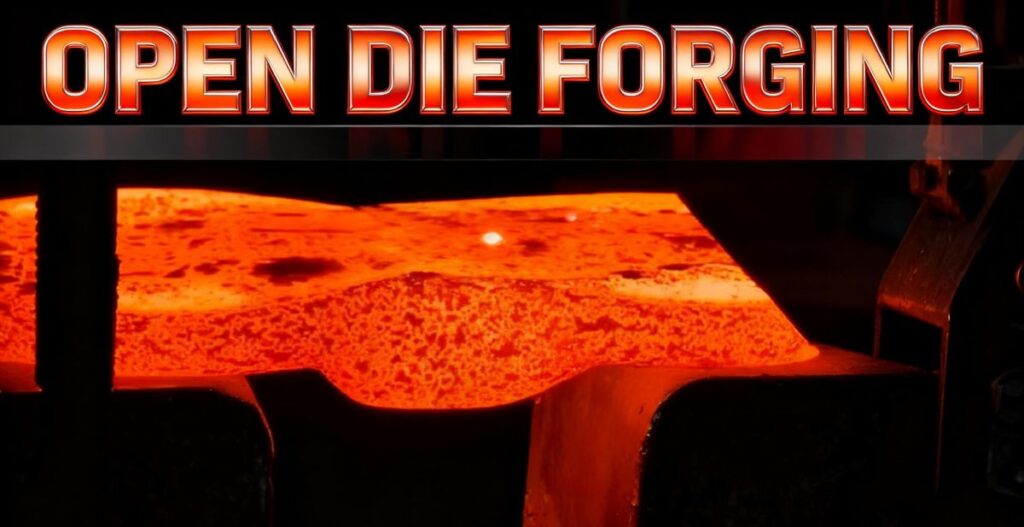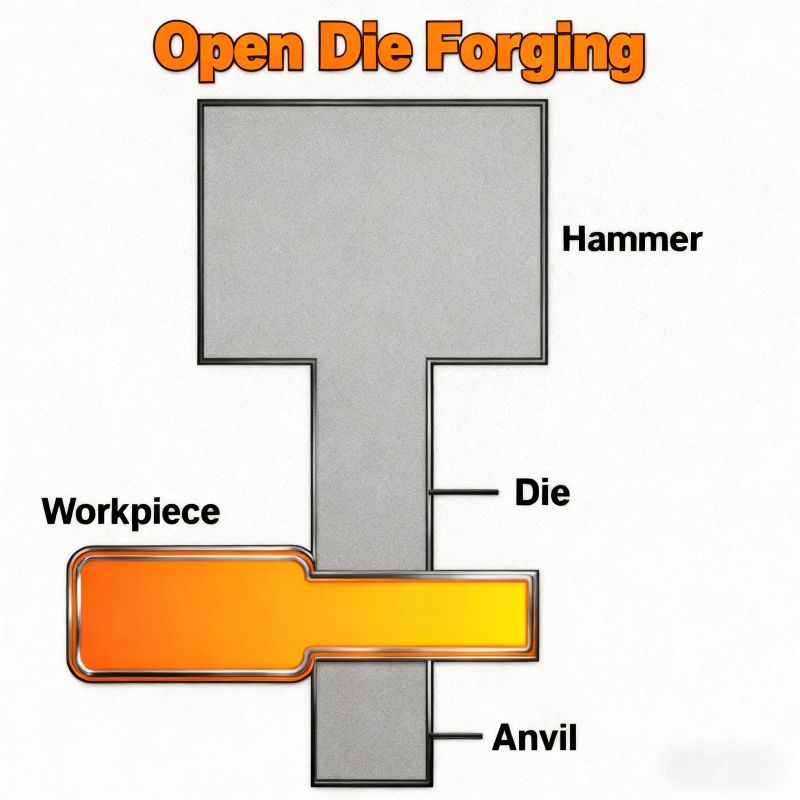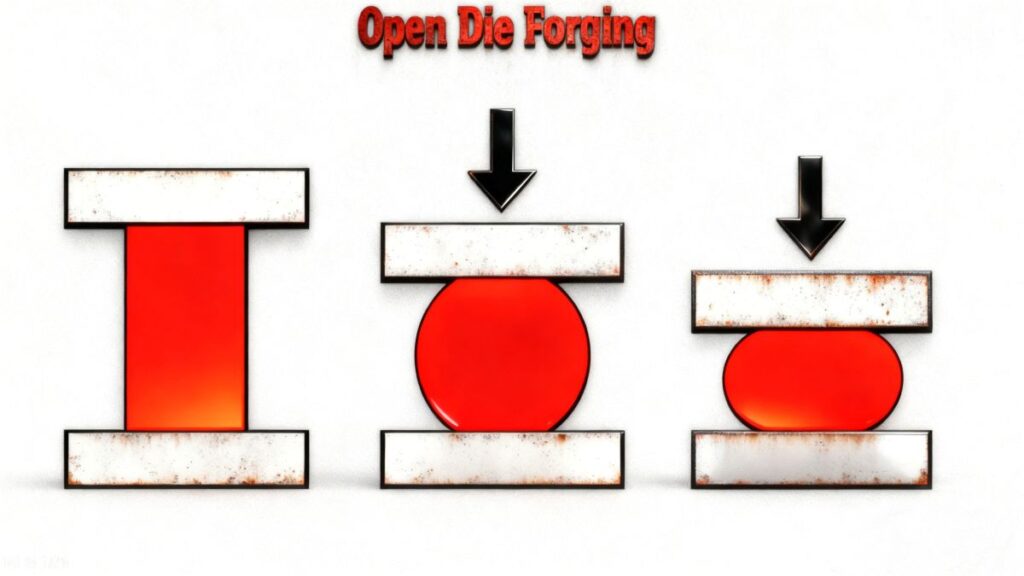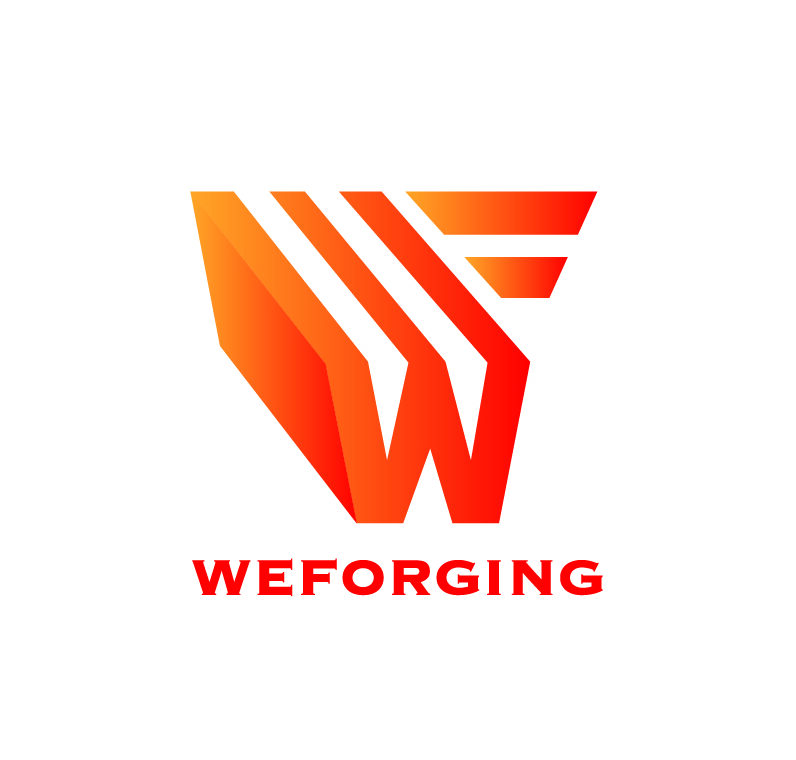What Is Open Die Forging?
What is open die forging, and why is it so critical for industries requiring large, high-strength, and high-performance components? From aerospace to energy and heavy machinery, the process plays a pivotal role in producing durable parts. Unlike closed die forging, which uses enclosed molds, open die forging shapes metal in an open mold, enabling the creation of large parts with excellent adaptability. This flexibility makes it a preferred method for applications such as aircraft engines, turbine shafts, and mining equipment.
This article explores the open die forging process, its benefits, applications, and key considerations for procurement managers and engineers when selecting the right forging solution.

What Is Open Die Forging?
Open die forging is a metal forming process where a heated billet is placed between two dies that do not completely enclose the material. Under controlled pressure, the billet is hammered or pressed repeatedly until it achieves the desired shape. Because the metal can freely flow, this process is especially suited for producing large or custom components that casting or closed die methods cannot easily achieve.
The method typically involves heating the billet to forging temperature and applying repeated strikes or compressions. This controlled deformation not only improves grain structure but also enhances strength and fatigue resistance. As a result, it is widely used in aerospace, energy, and heavy machinery, where durable and precision-engineered components are critical.

The Open Die Forging Process
The open die forging process begins with heating a metal billet to the ideal temperature for forming. Once heated, the billet is positioned between the open dies, where controlled pressure shapes the material through repeated strikes or gradual compression. This method not only creates the desired geometry but also refines the internal grain structure, enhancing overall strength and durability.
The main stages of the forging process include:
- Heating – The billet is brought to the proper temperature, improving its plasticity and making it easier to form.
- Forging – Under precise pressure, the heated billet is shaped between the dies. The metal gradually takes form, achieving the required dimensions while maintaining excellent structural integrity.
- Cooling and Heat Treatment – After shaping, the part is cooled in a controlled manner. Additional processes such as quenching and tempering may be applied to further improve hardness and performance.
- Final Processing – To achieve exact specifications, post-forging operations such as CNC machining or surface finishing are carried out, ensuring accuracy, smoothness, and readiness for application.

Advantages of Open Die Forging
Open die forging offers important advantages, especially in strength, efficiency, and versatility.
- Strength and Reliability: This process refines the grain structure, improving tensile strength and fatigue resistance for dependable performance.
- Large Part Capability: Unlike other methods, open die forging produces oversized components such as turbine shafts and heavy-duty gears.
- Material Efficiency: With less waste than casting, it helps reduce raw material costs and supports sustainable manufacturing practices.
- Customization: Open die forging provides flexible options, creating parts with tailored shapes and sizes to match engineering requirements.
Open Die Forging vs Closed Die Forging Comparison
In metal forming, open die forging and closed die forging are two primary methods, each with its own unique advantages and applications.
Feature | Open Die Forging | Closed Die Forging |
Process | Uses open molds where the metal is free to flow, suitable for large and complex parts. | Uses fully enclosed molds, ideal for mass production with precise dimensions. |
Advantages | Flexible, ideal for custom production and small batch runs, produces larger parts. | Suitable for mass production, highly accurate and consistent, faster for standard parts. |
Applications | Aerospace, energy, heavy machinery, custom parts. | Automotive, electronics, high-volume standard parts. |
Open die forging applications and types
Open die forging is widely used to manufacture oversized, high-strength components as well as medium and smaller parts requiring strict durability. During forming, the process refines the grain structure of the metal, improving toughness and extending fatigue life. As a result, it is trusted in industries with rigorous safety and performance demands, including aerospace, wind power, automotive, and heavy equipment.
In terms of geometry, this forging method is especially suitable for several core categories:
Cylindrical and long shapes – bars, shafts, and spindles.
Flat or upset shapes – thin, wide disc-shaped forgings.
Hollow forms – sleeves, rings, and tubular parts.
Contour-type forgings – step shafts, hubs, mandrels, and beams.
Typical products include forged discs, hollow rings, pierced blanks, metal shells, and large gear rings. These components are widely applied in power generation, mining equipment, and construction machinery. Moreover, the process can produce extremely large forgings, with lengths up to several dozen meters and weights exceeding 100 tons, showcasing its unmatched value in large-scale manufacturing.
How to Choose the Right Open Die Forging Company
When selecting an open die forging company, procurement managers should consider several important factors to ensure collaboration with a skilled and dependable manufacturer.
- Material Quality – Using high-quality raw materials is the foundation of durable forged components. Trusted manufacturers maintain consistent quality control throughout production, ensuring reliable performance.
- Technical Expertise – Companies with extensive experience and advanced engineering capabilities can successfully produce complex or large-scale parts while maintaining precision and mechanical strength.
- Reliable Delivery – Timely delivery plays a vital role in industrial projects. A supplier with a proven history of meeting schedules supports efficient operations and smooth project progress.
- Testing and Inspection – Employing advanced testing methods, such as ultrasonic inspection, metallographic analysis, and hardness testing, helps confirm that forged components meet international standards and deliver dependable results in critical applications.
By considering these aspects, procurement teams can build strong, long-term partnerships with forging companies that contribute to project success and sustainable growth.
Conclusion
Open die forging offers unmatched flexibility, strength, and customization, making it an ideal choice for producing large, high-performance parts in industries such as aerospace, automotive, mining, and energy. Its ability to produce high-strength, low-waste components ensures its continued importance in modern manufacturing.
At Weforging, we combine advanced forging technology, CNC machining, and stringent quality control to provide reliable, high-quality open die forging solutions. Whether you need standard or customized components, our team is ready to support your project.
Contact us today to discuss how our open die forging solutions can meet your needs.
F.A.Q.
Common materials include carbon steel, alloy steel, stainless steel, aluminum, copper, and titanium alloys. The choice depends on strength, toughness, and wear resistance requirements.
Dimensional accuracy in open die forging is generally lower than closed die forging, but with CNC machining and finishing, parts can meet strict tolerances and surface requirements.
At Weforging, we produce forgings ranging from 0.05 kg to 150 kg. With integrated CNC machining and rigorous quality inspections (ultrasonic, metallography, hardness, and CMM testing), we deliver customized solutions for global clients.

